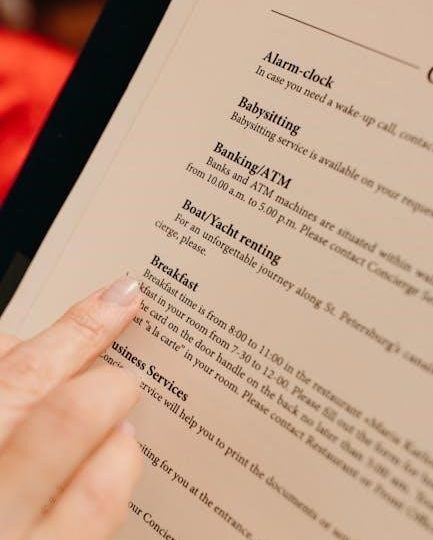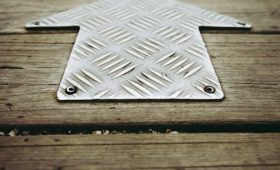Boat lifts are essential for protecting and maintaining watercraft by lifting them above water, preventing hull damage and corrosion. They enhance stability, reduce maintenance, and offer convenience for boat owners, ensuring safe docking and undocking. Guides and accessories further improve functionality, making boat lifts a vital investment for enthusiasts seeking durability and efficiency in various water conditions.
What Are Boat Lifts?
A boat lift is a mechanical device designed to lift and suspend a boat above water, protecting it from damage, corrosion, and marine growth. It operates using winches, hydraulics, or electric motors to raise and lower the boat, providing secure storage and easy access. Boat lifts are typically mounted on docks or piers and come in various types, such as vertical, elevator, and hydraulic models, each suited for different watercraft sizes and environments. They are an essential tool for boat owners seeking to maintain their vessels and extend their lifespan.
The History of Boat Lifts
Boat lifts have evolved significantly over the years, from basic manual systems to advanced hydraulic and electric models. Early versions were simple winch-based designs, while modern lifts incorporate sophisticated technology for effortless operation. The introduction of guide-ons and accessories has further enhanced functionality, ensuring precise alignment and protection for boats. This progression reflects the growing need for efficient and reliable boat storage solutions, making boat lifts an indispensable tool for watercraft owners seeking durability and convenience.
Why Use a Boat Lift?
Using a boat lift offers numerous benefits, including protection from water damage and corrosion, enhanced stability, and reduced maintenance. It prevents hull damage caused by constant exposure to water and marine life. Boat lifts also make docking and undocking easier, especially with the help of guide-ons that ensure precise alignment. Additionally, they provide a convenient way to store your boat, keeping it secure and ready for use. Investing in a boat lift is a smart decision for any boat owner looking to prolong their vessel’s lifespan and simplify ownership responsibilities.
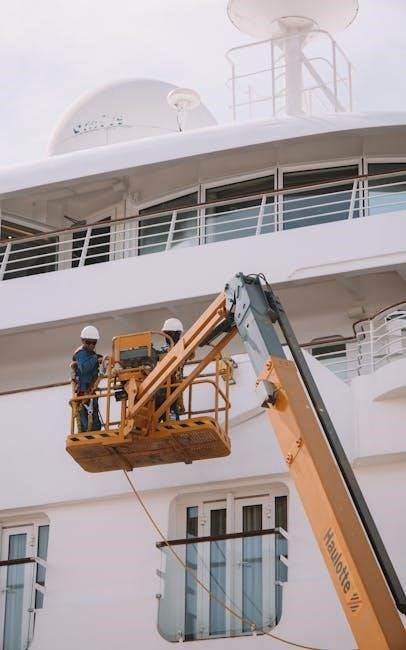
Types of Boat Lifts
Boat lifts come in various types, each designed for specific needs. Vertical lifts are common for shallow waters, while elevator lifts suit narrow spaces. Hydraulic lifts offer smooth operation, and manual lifts provide a cost-effective solution. Each type ensures secure and efficient boat handling.
Vertical Boat Lifts
Vertical boat lifts are a popular choice for shallow waters and offer excellent durability. They operate by lifting the boat straight up using sturdy columns, making them ideal for rough conditions. Constructed from durable materials like aluminum or steel, they provide reliable support. Guides are often integrated into these lifts to ensure proper alignment and prevent damage. Vertical lifts are versatile, accommodating various boat sizes, and are known for their simplicity and effectiveness in protecting watercraft. They are a practical solution for many boat owners seeking secure storage.
Elevator Boat Lifts
Elevator boat lifts use a winch system to raise and lower boats, ideal for narrow waterways. They offer compact installation and minimal waterway obstruction, making them perfect for tight spaces. These lifts are highly adaptable, accommodating various boat sizes. Guides are often added to enhance stability and alignment, ensuring smooth operation. Elevator lifts are preferred for their efficiency and space-saving design, providing reliable performance in challenging environments. They are a great option for boat owners needing versatile and practical solutions for their watercraft.
Hydraulic Boat Lifts
Hydraulic boat lifts are powerful systems that use hydraulic cylinders to lift and lower boats efficiently. Known for their strength and speed, they are ideal for larger watercraft and heavy-duty use. These lifts often feature advanced guide systems to ensure precise alignment and stability. Constructed with durable materials like heavy-duty steel, hydraulic lifts provide long-lasting performance; They are particularly popular in rough water conditions due to their robust design. With minimal maintenance requirements, hydraulic boat lifts offer a reliable and efficient solution for securing and protecting boats of various sizes.
Manual Boat Lifts
Manual boat lifts are cost-effective, non-motorized systems ideal for small boats and shallow waters. They operate via a hand-crank or winch, requiring physical effort to lift and lower the boat. These lifts are often preferred for their simplicity and lack of reliance on electricity. Guide-ons or posts are commonly used to align the boat during lifting. While labor-intensive, manual lifts are durable, low-maintenance, and environmentally friendly, making them a practical choice for owners of smaller watercraft seeking a straightforward, budget-friendly solution for boat storage and protection.
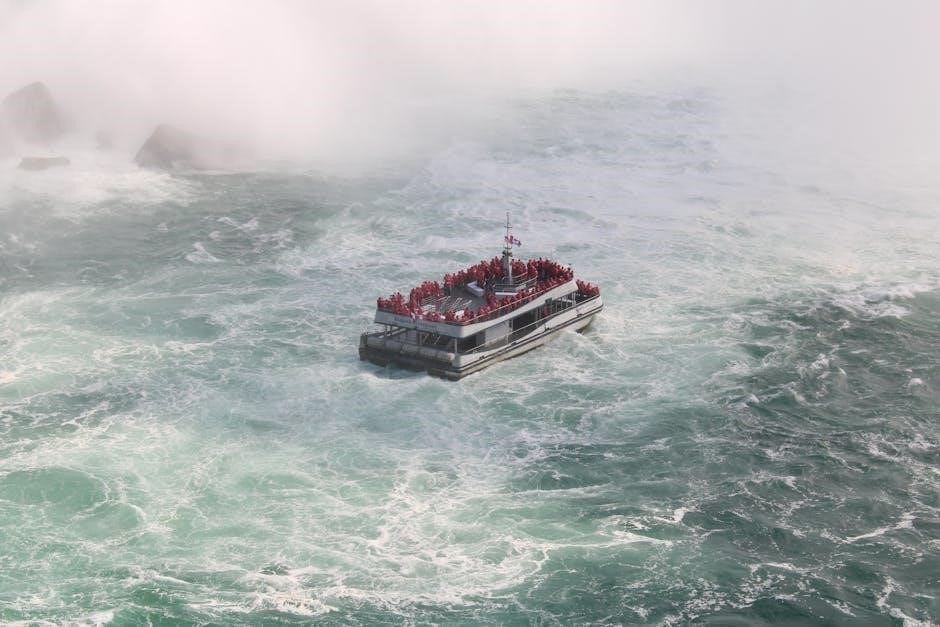
Boat Lift Guides: Definition and Purpose
Boat lift guides are essential accessories that help align and stabilize boats during lifting, ensuring proper positioning and preventing damage. They enhance safety and operational efficiency.
What Are Boat Lift Guides?
Boat lift guides are accessories designed to assist in aligning and positioning a boat onto a lift. They provide stability and prevent damage during the loading and unloading process. These guides attach to the lift structure and help navigate the boat into the correct position, ensuring smooth operation. Made from durable materials like PVC, aluminum, or wood, they protect the boat’s hull from scratches and dents. Guides are essential for maintaining the integrity of both the boat and the lift system.
By guiding the boat along the lift, these accessories reduce the risk of collisions and misalignment. They are particularly useful in windy or choppy water conditions, where stabilizing the boat can be challenging. Available in various configurations, boat lift guides are tailored to different boat sizes and types, ensuring compatibility and effectiveness. Their primary purpose is to enhance safety, convenience, and protection for boat owners.
How Boat Lift Guides Work
Boat lift guides function by providing a structured pathway for the boat to enter and exit the lift. They are attached to the lift’s framework and extend outward, offering a clear alignment for the boat’s hull. As the boat approaches, the guides help center it, reducing swaying and misalignment. Adjustable models allow customization to fit various boat sizes and styles, ensuring precise positioning. By guiding the boat along the lift, these systems minimize the risk of damage to both the vessel and the lift itself, enhancing overall safety and efficiency.
Guides work in tandem with the lift’s mechanics, stabilizing the boat during elevation and lowering. Their design ensures smooth transition, even in choppy waters, by maintaining consistent alignment. This streamlined process not only protects the boat but also simplifies docking and undocking, making boat ownership more convenient and stress-free for users.
Benefits of Using Boat Lift Guides
Boat lift guides provide numerous advantages, including enhanced stability and protection for your vessel. They prevent scratches and damage by guiding the boat into the lift accurately. Guides also reduce wear and tear on both the boat and lift, ensuring longevity. Additionally, they simplify docking and undocking, especially in windy or choppy conditions. By maintaining proper alignment, guides minimize the risk of collisions and misplacement. Overall, they offer convenience, peace of mind, and long-term cost savings, making boat ownership more enjoyable and stress-free.
Furthermore, guides adapt to various boat sizes and styles, ensuring compatibility and versatility. Their adjustable designs allow for customization, catering to different watercraft needs. This adaptability enhances the overall efficiency of the boat lift system, providing a secure and reliable solution for boat storage and maintenance.

Types of Boat Lift Guides
Boat lift guides come in various styles, including post, side, centering, and adjustable options, each designed to securely align and protect your boat during lifting and storage.
Post Guides
Post guides are vertical structures installed on boat lifts to help align and stabilize watercraft during docking. Made from durable materials like PVC, aluminum, or composite, they prevent damage by keeping the boat centered. Adjustable post guides offer flexibility, ensuring a secure fit for various boat sizes. Some models feature protective covers to safeguard the boat’s hull and decals. Easy to install, post guides enhance docking precision, reducing the risk of collisions and scratches. They are a practical solution for maintaining your boat’s appearance and structural integrity while using a lift.
Side Guides
Side guides are horizontal or angled structures mounted on the sides of boat lifts to assist in aligning and stabilizing watercraft. They provide lateral support, preventing the boat from shifting during docking. Often made of durable materials like aluminum or PVC, side guides protect the boat’s hull and lift from impact. Adjustable models allow customization to fit various boat widths, ensuring a snug and secure fit. They are particularly useful in windy or choppy conditions, offering enhanced stability and peace of mind for boat owners. Side guides are a practical addition to any boat lift system.
Centering Guides
Centering guides are designed to gently align and center a boat as it enters the lift, ensuring proper positioning. They typically consist of vertical posts or flexible arms placed along the lift’s centerline. These guides reduce the risk of misalignment, preventing damage to the boat and lift. Adjustable centering guides can accommodate various boat sizes and styles, offering a customized fit. They are especially beneficial for larger boats or in challenging docking conditions, providing stability and ease of use. Centering guides enhance the overall efficiency and safety of the boat lift system.
Adjustable Guides
Adjustable guides offer flexibility and customization for various boat sizes and styles. They can be tailored to fit specific vessel dimensions, ensuring precise alignment and secure docking. These guides are ideal for boat owners with multiple watercraft or those needing versatility. Made from durable materials like PVC or aluminum, they are resistant to corrosion and wear. Adjustable guides enhance docking ease, reduce alignment challenges, and protect both the boat and lift from potential damage. Their adaptability makes them a practical choice for diverse boating needs and water conditions.

Materials Used for Boat Lift Guides
Boat lift guides are crafted from durable materials like PVC, aluminum, wood, and composite options, ensuring longevity and resistance to water and weather conditions.
PVC Guides
PVC guides are a popular choice for boat lifts due to their durability and low maintenance. They are designed to protect your boat’s hull and gel coat by only touching the rub rail. Available in single or double sets, PVC guides are adjustable to fit various boat sizes and styles. Their smooth surface ensures safe and easy docking, while their resistance to water and weather conditions makes them a practical option for long-term use. PVC guides are also lightweight and easy to install, enhancing the overall functionality of your boat lift system.
Aluminum Guides
Aluminum guides are durable, rust-resistant, and lightweight, making them ideal for boat lifts; They are available in various styles, including carpeted or vinyl-wrapped options to protect your boat’s hull. Aluminum guides are versatile and compatible with different boat types, offering enhanced stability during docking. Their robust construction ensures long-lasting performance in harsh marine environments. Easy to install and maintain, aluminum guides provide a reliable and secure docking experience, adapting to your boat’s specific needs while ensuring smooth operation of your lift system.
Wood and Vinyl Guides
Wood and vinyl guides offer a durable and low-maintenance option for boat lifts. Vinyl-wrapped wood guides provide a smooth, non-marring surface that protects your boat’s hull from scratches. These guides are resistant to rot and decay, making them ideal for freshwater environments. They are often paired with aluminum frames for added strength and stability; Wood and vinyl guides are easy to install and come in various styles to suit different boat types. Their traditional appeal and functionality make them a popular choice for boat lift systems, ensuring secure and precise docking every time.
Composite Materials
Composite materials are a popular choice for boat lift guides due to their durability and resistance to rot, corrosion, and UV damage. These materials combine the strength of elements like fiberglass and polymer resins, creating a long-lasting solution. Composite guides are lightweight yet sturdy, offering excellent stability and protection for your boat. They are easy to maintain and can withstand harsh marine environments. Many composite guides are adjustable, allowing for precise alignment with your boat’s hull. Their versatility and low-maintenance requirements make them a practical option for boat lift systems, ensuring smooth and secure docking every time.

Popular Brands for Boat Lift Guides
Leading brands like ShoreMaster, Sunstream, HydroHoist, and Craftlander offer high-quality guide systems, ensuring durability, ease of use, and compatibility with various boat lift models, enhancing docking efficiency and safety.
ShoreMaster Guides
ShoreMaster guides are renowned for their durability and innovative design, offering maintenance-free PVC options that protect boats without touching the hull. Designed to align perfectly with the rub rail, they prevent scratches and damage, ensuring your vessel stays pristine. Available in single or double sets, ShoreMaster guides are compatible exclusively with ShoreMaster lifts, providing a seamless integration. Their adjustable features and robust construction make them a top choice for boat owners seeking reliability and long-term protection for their watercraft in various water conditions.
Sunstream Boat Lift Guides
Sunstream Boat Lift Guides offer innovative solutions for secure and easy docking. Their range includes guide-ons and bow stops, designed for compatibility with the SunLift SLX. These accessories feature a unique shape, enhancing functionality and protection for various boat types. Sunstream’s guides are built to adapt to specific needs, ensuring proper alignment and minimizing damage. They are part of a comprehensive system that prioritizes ease of use and durability, making them a reliable choice for boat owners seeking efficient and safe lift operations, especially for pontoons and wake boats.
HydroHoist Guide Systems
HydroHoist Guide Systems are renowned for their durability and adaptability, offering tailored solutions for various boat sizes and types. Designed with high-quality materials, these systems provide enhanced stability and protection during docking. Their guide-ons are adjustable, ensuring a perfect fit for different watercraft. HydroHoist’s step-by-step installation guide makes setup straightforward, ensuring confidence for boat owners. These systems are built to withstand harsh marine conditions, offering long-lasting performance and ease of use. Their innovative designs simplify the docking process, making HydroHoist a trusted choice for secure and efficient boat lift operations.
Craftlander Guides
Craftlander Guides are designed for compatibility with Craftlander and NuCraft vertical boat lifts, offering reliable support during docking. Available in full-length carpeted, foam upright, and vinyl pontoon side guide kits, they provide gentle, non-marring protection for various boat types. These guides enhance stability and simplify the process of parking and exiting the lift. Craftlander’s systems are built to last, ensuring durability and ease of use, while their customer-focused designs cater to specific watercraft needs, making them a practical choice for boat lift owners seeking efficiency and protection.
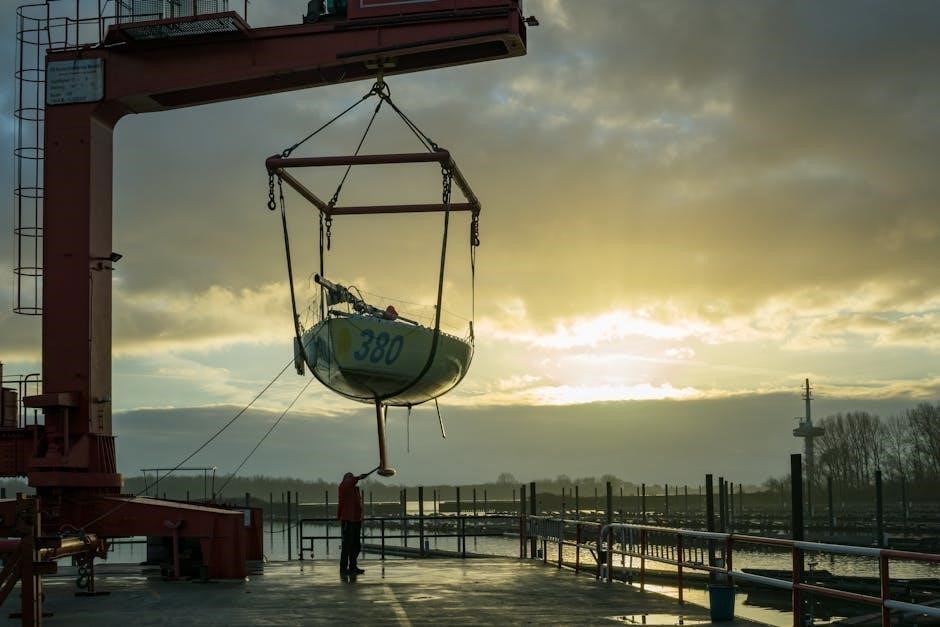
Installation and Maintenance of Boat Lift Guides
Ensure proper alignment and secure hardware during installation. Regularly inspect guides for wear and adjust as needed to maintain efficiency and protect your boat from damage.
Step-by-Step Installation Guide
Begin by assessing your boat lift and surrounding area to determine optimal guide placement. Mount the guide posts securely to the lift frame using provided hardware. Adjust the guides to align with your boat’s rub rail, ensuring they don’t touch the hull. Tighten all hardware firmly and test the system by guiding your boat onto the lift. Regular checks and adjustments ensure longevity and proper functionality, safeguarding your vessel and lift from damage.
Regular Maintenance Tips
Regular maintenance ensures boat lift guides function optimally and prolong their lifespan. Inspect guides for damage or wear, replacing any compromised components promptly. Clean surfaces to prevent debris buildup, which can hinder alignment. Lubricate moving parts to maintain smooth operation and prevent corrosion. Check hardware for tightness and adjust guides as needed to ensure proper alignment with your boat. Schedule annual professional inspections to address any potential issues early. Consistent upkeep safeguards your investment and ensures safe, efficient boat handling.
Troubleshooting Common Issues
Common issues with boat lift guides include misalignment, wear on surfaces, and hardware loosening. Check guide alignment regularly and adjust if necessary to prevent boat damage. Inspect for worn or damaged components and replace them promptly to maintain functionality. Tighten all hardware to ensure stability and proper operation. Clean surfaces to remove debris that may cause misalignment. Addressing these issues early prevents costly repairs and ensures smooth, safe boat handling. Regular inspections and timely fixes keep your boat lift guides functioning effectively.

Boat Lift Guide Accessories
Accessories like mounting hardware, adjustable brackets, and protective covers enhance functionality. Lighting systems improve visibility, while guide-ons and bumpers ensure precise alignment and protection for your boat and lift.
Mounting Hardware
Mounting hardware is crucial for securing guide-ons to your boat lift. Durable materials like stainless steel or galvanized metal ensure long-lasting performance. Adjustable brackets allow customization, fitting various lift models. These components are designed to withstand harsh marine environments, providing stability and alignment for your boat. Proper installation of mounting hardware ensures smooth operation and protects your vessel from damage. Accessories like bolts and nuts are often included, making installation straightforward and efficient. They are essential for maintaining the structural integrity of your boat lift system.
Adjustable Brackets
Adjustable brackets are versatile accessories for boat lift guide systems, offering customization to fit various boat sizes and lift configurations. Made from durable materials like stainless steel or galvanized metal, these brackets ensure secure and stable positioning. They allow for horizontal and vertical adjustments, accommodating different water levels and boat designs. Easy to install, adjustable brackets enhance the functionality of your guide-ons, ensuring precise alignment and protecting your vessel from damage. Their flexibility makes them ideal for boat owners seeking a tailored fit for their lift system.
Protective Covers
Protective covers are essential accessories for boat lift guides, designed to shield them from environmental elements and extend their lifespan. Made from durable, weather-resistant materials like vinyl or polyester, these covers prevent corrosion, UV damage, and mold growth. They fit securely over guide posts or brackets, maintaining their functionality while ensuring a pristine appearance. Easy to install and remove, protective covers are a practical solution for preserving your investment and keeping your boat lift system in optimal condition year-round, even in harsh marine environments.
Lighting Systems
Lighting systems for boat lift guides enhance visibility and safety during low-light conditions, making docking and undocking easier. LED lights are commonly used for their energy efficiency and durability. Motion sensor-activated lights provide convenience, turning on automatically when needed. Solar-powered options are also available, offering an eco-friendly solution. These lighting systems not only improve safety but also add a layer of convenience, ensuring your boat lift remains functional and accessible at any time of day, while protecting your investment and ensuring smooth operations.

Boat Lift Guide Regulations and Safety
Compliance with local and state regulations is crucial for safe boat lift operations. Adhering to safety guidelines prevents accidents and ensures environmental protection. Regular inspections and proper installation maintain structural integrity, safeguarding your boat, lift, and surrounding ecosystem.
Local and State Regulations
Local and state regulations govern the installation and operation of boat lifts to ensure environmental safety and structural integrity. These regulations often include height restrictions, material standards, and setback requirements to preserve waterways and neighboring properties. Compliance is mandatory to avoid fines and legal issues. Authorities may require permits and periodic inspections to ensure adherence to these rules, which vary by jurisdiction. Staying informed and adhering to these guidelines is essential for responsible boat lift ownership and operation.
Safety Precautions
Safety precautions are crucial when operating boat lifts to prevent accidents and ensure smooth functionality. Always inspect the lift and guides before use, checking for wear or damage. Properly secure the boat with straps and ensure balanced loading to avoid tipping. Keep bystanders at a safe distance during operation. Regular maintenance, including lubrication of moving parts and inspection of electrical components, is essential. Follow the manufacturer’s guidelines and consider professional installation to minimize risks and ensure a safe environment for boating activities.
Environmental Considerations
Environmental considerations are key when selecting boat lift guides to minimize ecological impact. Eco-friendly materials like PVC and aluminum are durable and resistant to corrosion, reducing the need for frequent replacements. Properly designed guides prevent damage to aquatic life by maintaining clear waterways. Regular maintenance ensures lifts operate efficiently, minimizing energy use and water displacement. Choosing sustainable materials and adhering to local regulations help preserve marine ecosystems while protecting your boat and lift system effectively.
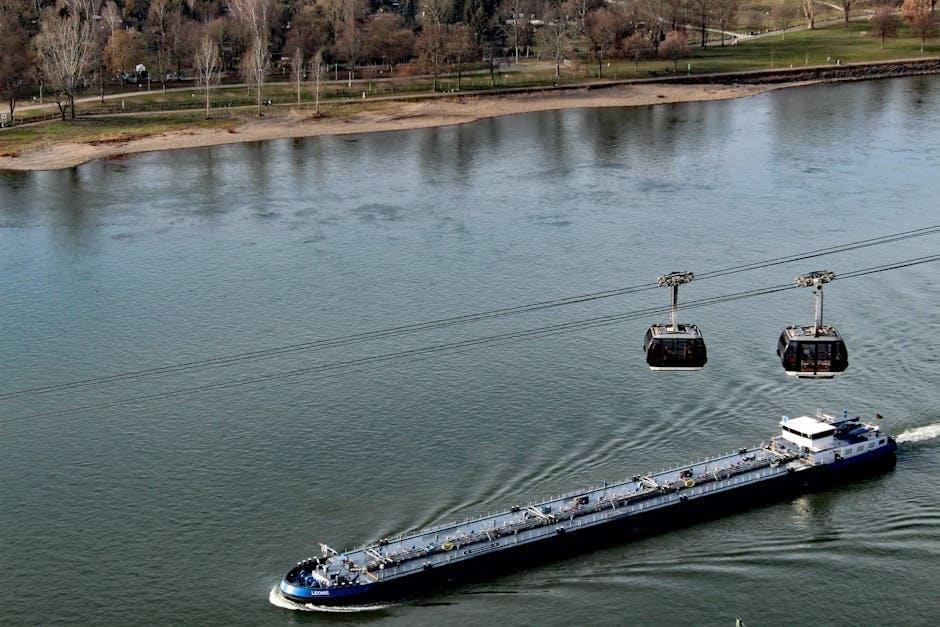
Choosing the Right Boat Lift Guide System
Selecting the right boat lift guide system involves considering your boat’s size, type, and hull design. Ensure compatibility with your lift and water conditions for optimal performance and durability.
Factors to Consider
When selecting boat lift guides, consider your boat’s size, type, and hull design. Ensure compatibility with your lift system and water conditions. Material durability, adjustability, and ease of installation are key. Choose guides that protect your boat’s finish and provide stable alignment. Consider the weight capacity and whether the guides are suitable for your boat’s beam and draft. Additionally, assess maintenance requirements and whether the guides are adaptable to different water levels or boat styles. Prioritize systems that offer both functionality and longevity.
Measuring Your Boat
Accurate measurements of your boat are crucial for selecting the right guides. Measure the beam (width) at the widest point and note the hull type (V-hull, pontoon, etc.). Check the rub rail position and height to ensure guides align properly. Record the overall length and draft to determine the appropriate guide height and spacing. Consider the boat’s weight and how it distributes on the lift. Proper measurements ensure a secure fit, preventing damage and enhancing stability. This step is essential for optimal guide performance and longevity.
Compatibility with Your Lift
Ensuring your boat lift guides are compatible with your lift is vital for safe and effective operation. Check the manufacturer’s specifications to confirm the guides fit your lift model, whether it’s a vertical, elevator, or hydraulic system. Compatibility ensures proper alignment and secure docking, preventing damage to both the boat and lift. Different lifts may require specific guide designs or materials, such as aluminum or PVC, to function optimally. Always verify compatibility before installation to guarantee a precise fit and reliable performance. Proper pairing enhances safety and extends the lifespan of your equipment.
Advantages of Using Boat Lift Guides
Boat lift guides enhance stability, protect your vessel from damage, and simplify docking. They ensure proper alignment, reduce wear and tear, and provide peace of mind for boat owners.
Enhanced Stability
Boat lift guides significantly improve stability by securely positioning the watercraft on the lift. This reduces swaying, especially in rough water, preventing potential damage to the boat or lift. Adjustable guides, like ShoreMaster’s maintenance-free PVC options, ensure a snug fit, keeping the boat centered and stable. Enhanced stability also makes docking easier, particularly for novice operators, and minimizes the risk of collisions with lift components. This feature is crucial for safeguarding both the vessel and the lift system in various water conditions, ensuring a secure and worry-free experience for boat owners.
Protection for Your Boat
Boat lift guides provide exceptional protection for your vessel by preventing direct contact with the lift’s structure. PVC posts, for instance, only touch the boat’s rub rail, safeguarding the hull and gel coat from scratches and damage. Adjustable guide systems, such as those from ShoreMaster, ensure proper alignment, reducing the risk of accidental bumps or collisions. This protective feature not only preserves the boat’s appearance but also extends its lifespan, offering peace of mind for boat owners in various water conditions and docking scenarios.
Convenience and Ease of Use
Boat lift guides enhance convenience by simplifying the docking process. Adjustable systems allow customization to fit various boat sizes, ensuring precise alignment. PVC posts are maintenance-free and gently guide the boat without causing damage. These features reduce the effort and time required to secure the boat on the lift, making boat lifts more user-friendly and efficient for owners.
